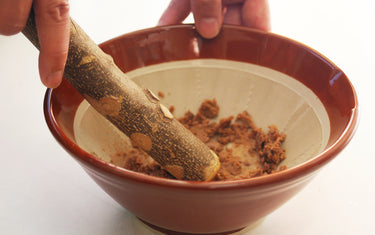“Crushing ingredients” is one of essential cooking techniques.
Such as herbs, spices, nuts, and grains, people have been struggling to crush or grind hard ingredients into powder.
Using a mortar and pestle is a standard worldwide. They are helpful to make mixed herbs or spices and a must when cooking curry.
It was found out that similar tools were used in Japan before the 6th century. After that, they have been developed and improved for further efficiency and delicate functionality. This is how Japanese mortar and pestle (called Suribachi and Surikogi respectively) were invented.
This time we would like to introduce Suribachi and Surikogi that have been used since establishment of Japanese cuisine.
What are Suribachi and Surikogi?
Same as mortars and pestles, Suribachi and Surikogi are used to crush or grind ingredients. However, they look somewhat different.
Suribachi

Suribachi features comb pattern inside. These fine gaps enable it to crush hard nuts or grains into powder. The comb pattern makes grinding easier.
It is said that the base of Japanese cuisine was established in 1300s (Muromachi Era), when Suribachi and Surikogi were invented. They appear in an old picture scroll drawn in 1351. They can be unsung heroes in the history of Japanese cuisine.
Surikogi
Same as pestles, Surikogi is a stick to crush or grind ingredients. There are several types of Surikogi, such as wooden ones similar to pestles, ones as tall as a kid, and ones with unique shape as shown in the right side of the picture.
Simply designed stick-shaped Surikogi is the most common and cheap. Long ones can grind more efficiently and reduce physical labour by putting your weight on them and applying the principle of leverage. They are used at restaurants serving Japanese traditional cuisine.
Surikogi has rugged surface and looks unique. It has been highly evaluated by professional chefs and used since ancient times. Surikogi is basically made of Japanese pepper (Sansho) wood, and there is a reason why it has been widely used so long.
The Reason People Choose Surikogi
For the same reason as wasabi is used for sushi, Sansho has been used for bactericidal purpose since the time when food storage technology was not developed yet.
Even today, when we have advanced food storage and transport technologies, Sansho is used at many restaurants to minimize food poisoning risk.
It takes much time and efforts for professionals to make Sansho wooden Surikogi. Basically, Sansho wood is processed into Surikogi a few months to a year after cut off.
For all these reasons, Sansho Surikogi is highly valued as Japanese traditional culture and widely used in modern Japan.
















